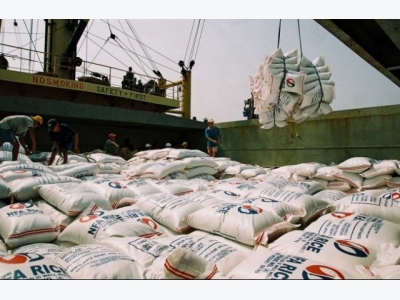Annual rice exports to be $2.5bn by 2030

Targets included in Development Strategy for Rice Export Markets in 2017-2020 and Vision to 2030.
Rice exports are expected to earn Vietnam from $2.3 to $2.5 billion annually during the 2021-2030 period, according to the Development Strategy for Rice Export Markets in 2017-2020 and Vision to 2030 approved recently by the Prime Minister.
The Ministry of Industry and Trade (MoT) has sent documents to the Ministry of Finance, the Ministry of Agriculture and Rural Development, the State Bank of Vietnam, the Vietnam Food Association, and other relevant ministries and agencies on the implementation of the strategy.
The strategy aims to enhance the competitiveness and brand of Vietnam’s rice exports and also defines market diversification, to reduce dependence on certain markets, match international integration trends, and seize the opportunities presented by free trade agreements.
The strategy includes two phases. The first, from 2017-2020, targets annual rice export volumes of 4.5-5 million tons with a value of $2.2-2.3 billion. The second phase, from 2021-2030, targets 4 million tons worth $2.3-$2.5 billion annually.
The export rice structure is to change by 2020, in which the volume of low-grade white rice is to not exceed 20 per cent, while Japonica will account for 30 per cent, sticky rice 20 per cent, and other rice 5 per cent.
By 2030, white rice is to account for only 25 per cent, average rice less than 10 per cent, Japonica rice 40 per cent, sticky rice 25 per cent, and other nutrient rice more than 10 per cent.
The strategy clearly identifies the export rate in each market by 2020. Exports to Asia are to account for 60 per cent, Africa 22 per cent, the Americas 8 per cent, Europe 5 per cent, Australia 3 per cent, and the Middle East 2 per cent.
Approved by the Prime Minister, the strategy also puts special emphasis on exports to markets such as Southeast Asia (the Philippines, Indonesia, and Malaysia), China, Japan, and South Korea.
The government also touches on the branding of Vietnamese rice and improving post-harvest technology and the processing of rice products. It will also invest in international-standard rice quality testing labs in the Mekong Delta, to facilitate quality control, contributing to the improvement of Vietnamese rice grains to national standards.
Related news
 Origin of much pork untraceable
Origin of much pork untraceable The origin of four-fifths of pork at HCMC’s Binh Dien wholesale market, which consumes a majority of pork from other provinces
 Philippine rice tender win buoys local price
Philippine rice tender win buoys local price That Vietnamese rice firms won in a Philippine tender last month to supply 175,000 tons of 25% broken rice has led to a steady price increase of IR 50404 rice
 Pork traceability violations to face steep fines
Pork traceability violations to face steep fines Vice chairman of HCMC Tran Vinh Tuyen said on August 8 the city is pushing for the implementation of a program to make sure all pork on sale has clear origin